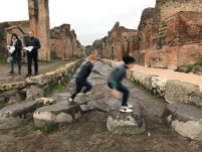Naples: home of Elena Ferrante and her Neapolitan novel series, limoncello, bufala mozzarella, and sfogliatelle, which is as fun to eat as it is to say. Well, actually it’s kind of messy but it’s delicious nonetheless.
We stayed in an 18th century apartment in a 4 story building that was originally a family home in the historic center of Naples. It is decorated in 18th century style and the ceilings must be 20 feet tall. Our street, via dei Tribunali, was the main east west street of the ancient, thriving Greek and Roman city of Neapolis. We were blocks from the best Neapolitan pizzerias in town and just down from the Duomo di Napoli. Naples had great wealth from the ancient times until Italian unification, but after it joined the united Italy in the late 1800s, its wealth was used to fund industrial expansion in the north, so the city lost its glamour. It was also the most bombed Italian city in World War II, as Naples was the first Italian city to rise up against German occupation.
The city has a scrappy feel (my man Rick Steves calls it a ‘tangled mess’) compared to other Italian cities, maybe thanks to influence from the Camorra, Naples’ mafia, which is the oldest crime organization in the country, dating back to the 17th century. It has lots of pretty areas and charm once you get used to the noise, the brazen scooters and the alley-like streets.
Our first day we walked the city, starting at the top rated sfogliatelle bakery, then taking funiculars from the old center to various points around town, ending the day along the water and through the Piazza del Plebiscito where the lights on the church reminded us of Denver’s civic center building. We stopped for dinner at an antique pizzeria where a popular, famous pizza was invented and named for Queen Margherita di Savoia. (The margherita pizza, of course.)
We spent our second day in Pompeii, the ancient Roman town that was destroyed in 79 AD when Mount Vesuvius erupted and buried the area under 15-20 feet of volcanic ash. The site was unknown for some 1500 years until the mid 1750s. The town and the objects found in it have been perfectly preserved because of the lack of air and moisture – and the artifacts gave historians detailed information and insight into life in an ancient Roman city. Walking through the ruins, you immediately notice how organized and efficient the city was planned out: market in the center, villas on one side, smaller houses on the other. Public areas close to the center, an amphitheater, roads for chariots and sewer waste. During excavation, plaster was used to fill in the spaces of the ash layers that once held human bodies, so archaeologists could see the exact position the people were in when they died. It was fascinating.
It was dark when we left Pompeii. From there we continued on the train to Sorrento, home of the famous lemons that make limoncello. It’s a beautiful area of Italy, with the Amalfi coast just to the east and the island of Capri right offshore. The buildings that stack from the top of the city down to the water gives it a cool dramatic look from the bottom. The holiday decorations were beautiful and the main square is really pretty. We had a quick dinner in Sorrento before boarding the train back to Naples that night. And from here, naturally, all roads lead to Rome.
Oh, and the cover picture on this page is a nativity scene made entirely of pizza.






















You make Naples sound so enchanting….and I don’t remember it like that at all :).
LikeLiked by 1 person
ha! i love how rick steves calls it a tangled mess. i thought that was pretty accurate. you should read the ferrante books. i really loved them and it made me want to see naples.
LikeLike